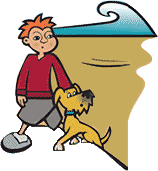New Zealand is a country surrounded by water, so many coastal communities are at risk from tsunami. In a near source tsunami the water level may fall very quickly past the normal low tide mark, then return just as quickly. If this happens, there won't be enough time to issue a warning and it is important that you know what to do, and that you act quickly.
WHAT IS A TSUNAMI?
Tsunami is a Japanese word meaning 'harbour wave'. A tsunami is a series of fast travelling waves caused by a large disturbance on the ocean floor, such as an earthquake, landslide, volcanic eruption or meteorite.
Tsunami waves appear either as rapidly-moving tides with very strong currents that can wash people and objects out to sea, or as large breaking waves that can cause significant impact damage at the shoreline.
Before

- Know if your local area could be struck by a tsunami.
- Talk with your family and prepare an emergency plan.
- Identify safe places close to your home and school - a place which is at least one kilometre inland or 35 metres above sea level.
During

- Stay calm.
- Leave the area immediately if you are on the beach or near a river when a strong earthquake occurs. Move quickly but safely.
- Go at least one kilometre inland or 35 metres above sea level.
- Don't go to a river or beach to watch the waves come in if a warning has been issued.
After

- Stay calm
- Listen to and follow instructions from adults or the radio.
- If you can, help others who may need it.


